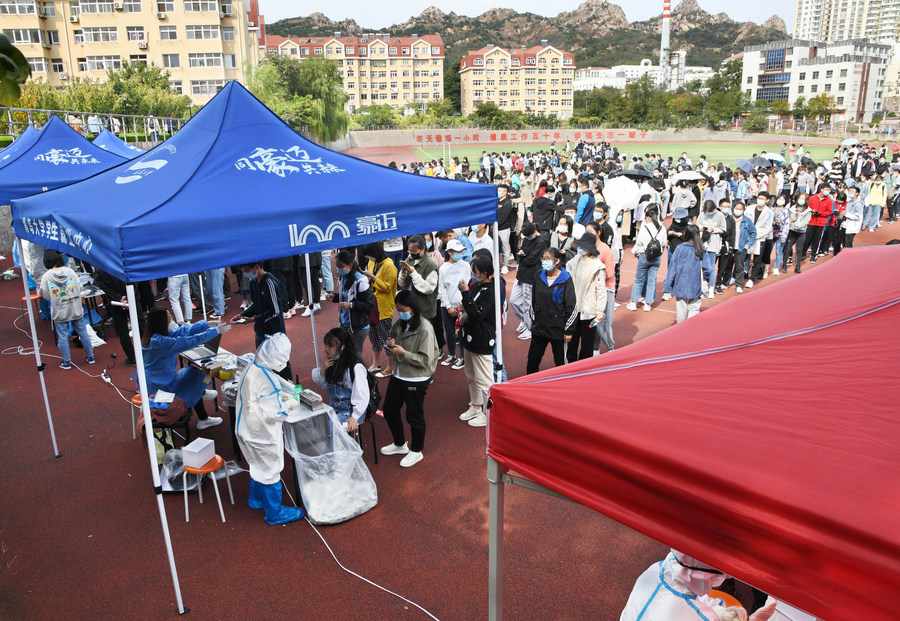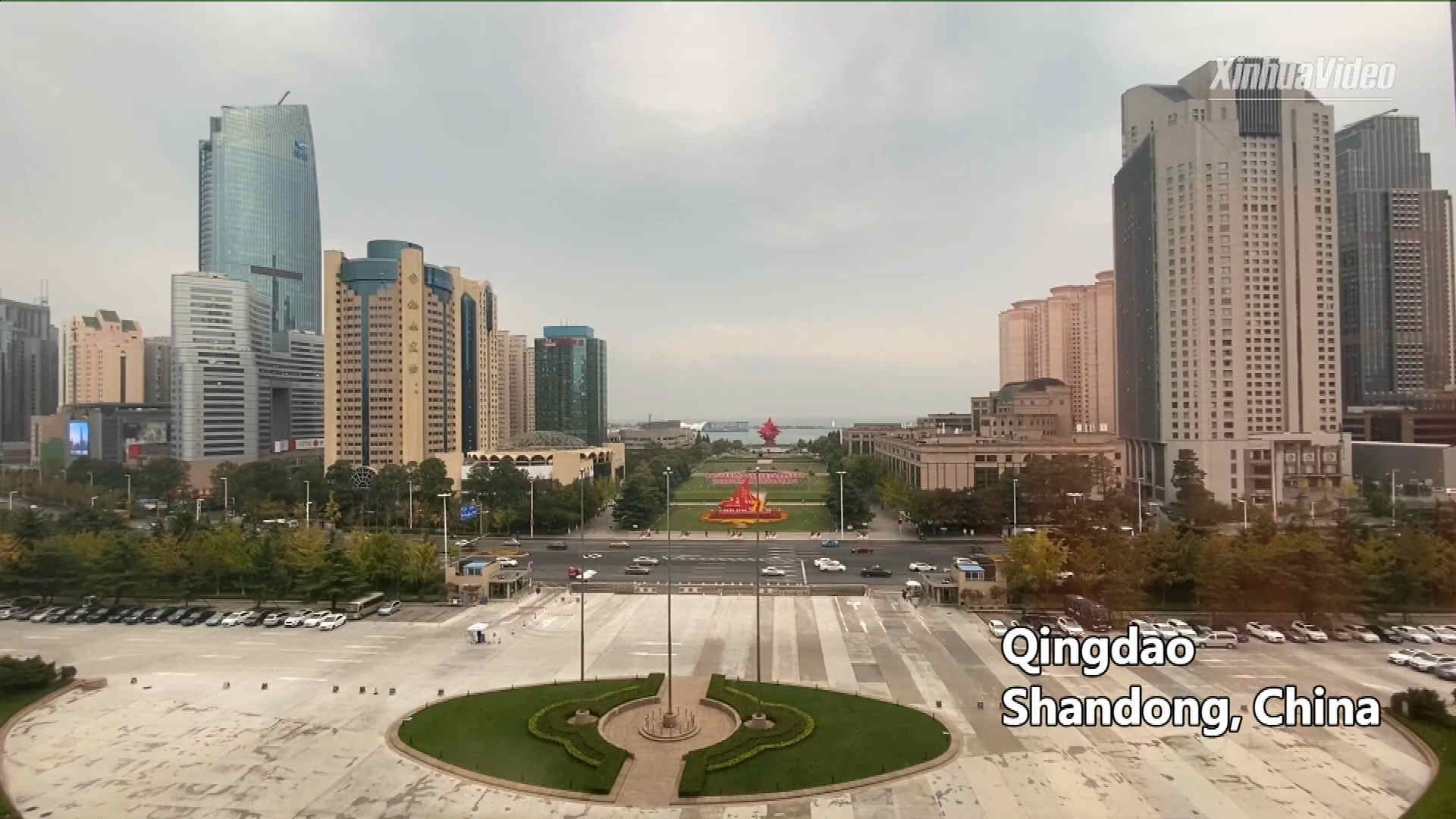

-- With swift response after local infections re-emerged, the eastern Chinese city of Qingdao has managed to safeguard China's success in epidemic control.
-- Given the uncertainty surrounding the source and scale of the new outbreak, Qingdao initiated a citywide nucleic acid testing campaign covering all 11 million residents and vowed to complete it within five days.
-- The increasing testing capacity in China supported the speedy citywide testing. Medical workers used batch testing to boost efficiency.
QINGDAO, Oct. 21 (Xinhua) -- In five whirlwind days, the city achieved an impressive turnaround: completing a citywide nucleic acid testing of 11 million residents, finding patient zero of a new cluster of local COVID-19 infections, and confirming no risk of community infections.
With its swift response after local infections re-emerged, the eastern Chinese coastal city of Qingdao has managed to safeguard China's success in epidemic control.
CITYWIDE TESTING
At midnight on Oct. 11, many residents in Qingdao still tossed and turned in bed, looking for information on the new local COVID-19 infections on their cellphones.
The local health commission reported three new asymptomatic cases of COVID-19 in the daytime, adding that the specific source of infection was still under investigation.
After another nine infections were reported around 3 a.m. on Oct. 12, the commission was worrying that COVID-19 was poised to make a comeback in the city.
Given the uncertainty surrounding the source and scale of the new outbreak, Qingdao initiated a citywide nucleic acid testing campaign covering all 11 million residents and vowed to complete it within five days starting from Oct. 12.

Students queue for COVID-19 tests at a stadium of Qingdao University in Qingdao, east China's Shandong Province, Oct. 13, 2020. (Xinhua/Li Ziheng)
Residents started to line up at testing points on squares and playgrounds as well as in parks. "It was a responsible move for the good of everyone," said a local resident surnamed Wang.
To ensure the citywide testing was completed on time, authorities in Shandong Province, where Qingdao is located, dispatched more than 1,200 medical workers from provincial hospitals and other cities to assist with testing, said Chen Wansheng, an official with the municipal government of Qingdao.
Luan Chunlei, a nurse from Longkou city, about 210 km away from Qingdao, worked from noon to 9 p.m. without food or drink on her day of arrival. "We have to change our protective suits after eating or drinking. It's a waste of time as so many people are waiting in line," said Luan.
More than 10,000 medical personnel were deployed to conduct sampling at over 4,000 locations, according to Chen.

A health worker takes a swab sample from a citizen for COVID-19 test in Qingdao, east China's Shandong Province, Oct. 12, 2020. (Xinhua/Li Ziheng)
The increasing testing capacity in China supported the speedy citywide testing. "The maximum daily testing capacity was only about 2,000 samples in February in Qingdao, and it has reached more than 260,000 now," said Xue Qingguo, deputy mayor of Qingdao.
Some of the samples in Qingdao were transported to neighboring cities for testing, as samples must be tested within 12 hours of collection, Zhao Guolei, deputy director of the municipal health commission, told Xinhua.
Medical workers used batch testing, which combines samples from no more than 10 people in a single test, to boost efficiency.

Staff members process swab samples to test for COVID-19 at a laboratory in Qingdao, east China's Shandong Province, Oct. 16, 2020. (Xinhua/Li Ziheng)
As of 6 p.m. on Oct. 16, nearly 10.9 million samples had been tested. Some testing points remained open for two more days, and 10.92 million samples had been tested as of 2 p.m. on Oct. 17, with no new positive samples found.
TRACKING PATIENT ZERO
The Shandong provincial government dispatched over 30 epidemiologists and nearly 800 police officers to investigate the infection source as well as the transmission route.
Based on over 10,000 hours of video footage and a large amount of spatio-temporal trajectory information, the investigation team confirmed that inappropriate disinfection in the CT room at the Qingdao Chest Hospital led to the new cluster of COVID-19 infections.
Two stevedores who had handled imported frozen seafood at the port of Qingdao were diagnosed as asymptomatic COVID-19 cases on Sept. 24. They were isolated at the Qingdao Chest Hospital and underwent CT scans in the hospital's CT room.
Due to improper disinfection, the CT room was contaminated and the virus further infected other people, said Ma Lixin, deputy Party chief of the provincial health commission.
Ma also noted that the new cluster infection was neither caused by nor has caused cross-infection in the community.
Deng Kai, president of the hospital, was removed from his post following the outbreak. Sui Zhenhua, director of the Qingdao municipal health commission, was suspended from office.
"We will learn from this painful lesson and crank up our epidemic prevention and control measures," said Xue.
The Chinese Center for Disease Control and Prevention (CDC) on Saturday confirmed the detection and isolation of living novel coronavirus on the outer packaging of imported frozen cod in Qingdao during an investigation to trace the source of the recent infections.
It is the first time anywhere in the world that living novel coronavirus has been isolated from the outer packaging of cold-chain food, China's CDC said, adding that contact with packaging contaminated by living novel coronavirus could lead to infection.
Looking ahead, Qingdao will conduct nucleic acid testing on all imported cold-chain products to enhance the prevention and control of COVID-19, the municipal government said on Tuesday.

A staff member processes swab samples to test for COVID-19 at a laboratory in Qingdao, east China's Shandong Province, Oct. 16, 2020. (Xinhua/Li Ziheng)
The city will also conduct COVID-19 tests, every three to five days, on personnel engaged in loading, unloading, handling and transporting imported cold-chain food in areas such as ports and cold storage facilities.
THREE PATIENTS CURED
A total of 13 confirmed cases were detected in the new cluster of infections, and three of them have been cured, said Luan Xin, deputy mayor of Qingdao, on Tuesday.
One of the three will be put under a further 14-day quarantine. The other two who had suffered from tuberculosis before the infections will stay in hospital for treatment of tuberculosis.
The Qingdao Chest Hospital, where the virus recently spread, specializes in treating tuberculosis, a disease common to seven out of the 13 confirmed cases.
Besides the nine medical experts who have been dispatched to the city for clinical treatment assistance, the National Health Commission sent a team of tuberculosis experts for help on Monday.
The commission has also urgently allocated 9,000 milliliters of convalescent plasma from recovered COVID-19 patients to assist medical treatment in Qingdao.
"COVID-19 and tuberculosis both damage the lungs, so it is challenging to treat the seven patients," said Sun Yunbo, vice president of the Affiliated Hospital of Qingdao University, who heads the city's team of medical experts for the treatment of COVID-19 patients. All confirmed cases are in stable condition, Sun added.


 Award-winning photos show poverty reduction achievements in NE China's Jilin province
Award-winning photos show poverty reduction achievements in NE China's Jilin province People dance to greet advent of New Year in Ameiqituo Town, Guizhou
People dance to greet advent of New Year in Ameiqituo Town, Guizhou Fire brigade in Shanghai holds group wedding
Fire brigade in Shanghai holds group wedding Tourists enjoy ice sculptures in Datan Town, north China
Tourists enjoy ice sculptures in Datan Town, north China Sunset scenery of Dayan Pagoda in Xi'an
Sunset scenery of Dayan Pagoda in Xi'an Tourists have fun at scenic spot in Nanlong Town, NW China
Tourists have fun at scenic spot in Nanlong Town, NW China Harbin attracts tourists by making best use of ice in winter
Harbin attracts tourists by making best use of ice in winter In pics: FIS Alpine Ski Women's World Cup Slalom
In pics: FIS Alpine Ski Women's World Cup Slalom Black-necked cranes rest at reservoir in Lhunzhub County, Lhasa
Black-necked cranes rest at reservoir in Lhunzhub County, Lhasa China's FAST telescope will be available to foreign scientists in April
China's FAST telescope will be available to foreign scientists in April